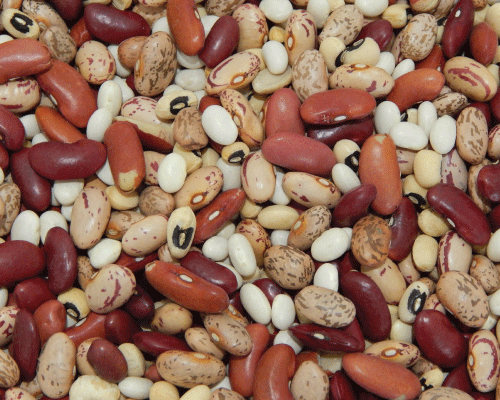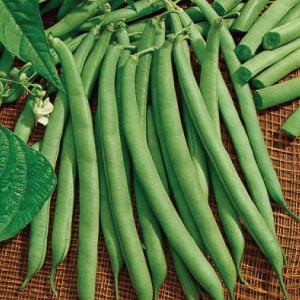
There are two main kinds of beans found in gardens, bush beans and pole beans, commonly known as green beans. The main difference between the two is the growing style – bush beans don’t require support as they grow whereas pole beans grow in a vining fashion and require stakes or trellises. Bush beans require less maintenance, though pole beans are disease resistant and produce more crop.
To plant:
As beans prefer warm weather, plant at least a week after the last spring frost. Bean seeds should not be started indoors. Plant seeds one inch deep. If you are planting bush beans, space seeds two inches apart. If you are planting pole beans, space seeds three inches apart along a trellis or fence row.
To grow:
For bean growth all summer long, sow every two weeks. Mulch the soil around the plant to retain moisture and prevent weeds and water regularly. Go easy on the fertilizer, as excessive nitrogen will produce much foliage with little crop. For bush beans, when seedlings develop leaves, thin the plants to six inches apart. Beans are susceptible to beetles, which can be removed by hand off the plant or sprayed with soapy water.
To harvest:
Beans should be ready to harvest as soon as 65 days after planting. When beans are ready to harvest, the seeds inside the pod are not quite full size. Harvestable beans should snap easily off the plant, and stored in airtight containers for up to four days after harvest.
Other varietals of beans:
There are more bean options than just the bush or pole varieties. Gardeners can add garbanzo, Great Northern and more beans to their garden based on their preferences. Many beans require the same or similar conditions as green beans, though types like garbanzos do take longer to grow prior to harvesting.
What beans crave:
Beans prefer warmer weather, so plant in full sun. Beans prefer soil with a pH between 6.0 and 7.0. Water plants regularly. Though compost can be worked into the soil prior to planting, don’t overfertilize the beans.
Where to buy bean seeds:
Find a wide variety of bush and pole beans, as well as other varieties such as garbanzo, Great Northern and others at Urban Farmer.
Learning Download: Common pests and diseases: Beans
Common pests and diseases: Beans
When growing vegetables, it is always exciting to care for the plant throughout its growing phase and then harvest it for delicious recipes later on, but one thing to watch out for is pests and diseases. Different plants are susceptible to different types of pests and diseases, and it is important to make yourself aware so you can keep a watchful eye and also take any preventative methods to keep your plants safe throughout their lifespan.
Beans can fall victim to several different pests and diseases, and since there are many different varieties of beans, different pests and diseases can affect different types of beans.
Pests:
Bean weevil is a pest that can cause damage to spring beans, but only if a high amount of the pests appear when the plants are still young. Leaves of the plants attacked by the bean weevil will show U-shaped bites around the edges. However, the worst damage is when the larvae eat the root nodules. To treat this, begin spraying as soon as you start to notice the signs. Continue spraying for 7 to 10 days. Bean weevil can affect winter beans as well, but winter beans are not as prone to this pest because they are typically too advanced in growth for the weevils to do much damage.
A major problem is field beans is the stem nodule. This pest causes the most problems during wet seasons, and it is seed-borne and also will infect soils, which makes it a problem for the next generation of crops planted in the area. You can test seeds for nematodes prior to planting.
The black bean aphid is a pest that can cause lots of damage to field beans, as well, especially if the colonies develop prior to the beans’ flowering season.
A pest that affects both the winter and spring beans is the bean seed beetle. Adult beetles lay eggs on developing pods during the bean’s flowering season, and the larvae then bore through the pod and into the seed. Once adults, they emerge from the seed leaving behind a circular hole.

Diseases:
Pests aren’t the only problem affecting bean plants, and diseases can wreak havoc on your beans, as well. A common disease affecting beans is downy mildew, because mildew is prevalent on spring beans. This disease causes a gray felt-like growth on the undersides of the leaves. This disease is treated with fungicides.
Another common disease is leaf and pod spot, which causes brown lesions with black fruiting bodies. Winter beans are more susceptible to this because oftentimes, the disease develops in wet conditions, but the disease is seed-borne, so ensure that you test all your seeds prior to planting.

